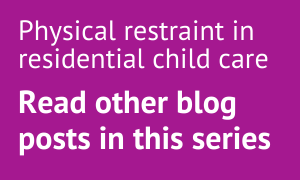Physical Restraint in Residential Child Care: A Watershed Moment?
Laura Steckley, a Senior Lecturer at the School of Social Work and Social Policy and CELCIS at the University of Strathclyde, explains how people are coming together to consider how to apply what we know about both experience and theory to address the practice of restraint in residential care.

Physically restraining children and young people is one of the most complex and contentious areas of practice in residential child care and recently, it has come under a spotlight here in Scotland. This recent focus has brought with it a galvanising energy. People want to take action. For that action to be a positive turning point, it must involve the perspectives of those with direct experience of restraint. It must also embrace multiple complexities – those inherent in restraint, and those that affect restraint. We may well look back on this time as a watershed moment in regards to the practice of physical restraint in residential child care, and a group of people have come together to seize this opportunity.
Starting a Conversation to Make Things Better
In the past several months, physical restraint in residential child care in Scotland has been the focus of at least one major Scottish newspaper article and has been raised in the evidence taking of the Scottish Parliament's Equalities and Human Rights Committee as they considered the Children (Equal Protection From Assault) (Scotland) Bill aimed at stopping the physical chastisement of children.
Those of us on the planning committee for the SIRCC Conference, along with others in the residential child care sector, detected an appetite for and, perhaps more importantly, a sense of urgency around widening the discourse on this very difficult area of practice. While dialogue is key in addressing the way physical restraint is used, experienced and understood in residential child care, we decided that the first step towards collective, sector-driven action needed to be something different than a plenary discussion.
We wanted to create an initial space in which the conference delegates were invited to be curious about the inherent ambiguities in physical restraint. We did so by presenting some of the many-layered complexities and ways of understanding physical restraint that must be considered if we are to effectively address this area of practice without doing further harm to children and young people, currently or in the future.
We wanted to incorporate a range of experiences from those most directly affected by physical restraint and those positioned to have direct influence on its use. So we had discussions with care experienced people, both those with experience in care and of providing care, and in some cases both. We also had discussions with close-in managers (sometimes referred to as unit managers), a further-distant manager (sometimes referred to as an external manager), and some inspectors from the Care Inspectorate. With their permission, we audio recorded these conversations and incorporated some of what they said into the presentation.
Coming Together to Make Things Better
The presentation was intended to be the start of an ongoing process of collective action to make things better. Delegates were invited to get involved in follow-up dialogue the following week about what they had heard and how we might proceed.
Given the relatively short notice for this coming together, I was heartened by the turnout for this dialogue – not only in terms of the number of people who joined but the openness and unflinching courage reflected in the discussions on the day. People with experience of being cared for and of providing care in residential child care services were present. There was a willingness to look at and discuss difficulties, places where we may be getting it wrong, as well as constructively exploring how to get it right.
On the day, people made the commitment to form a group that would engage in further dialogue and action. This group is not interested in casting aspersions or looking down on other services from a place of moral high-ground; rather, it is committed to figuring out, together, how to make improvements despite the wider contextual obstacles and without related efforts being at the expense of children, young people or those who care for them.
Residential Child Care as Intellectual Work
There were many things I spoke about in that presentation for the SIRCC Conference that I would like to write more about, but for this blog post my focus is this: residential child care is intellectual work. I made this assertion deliberately to provoke thought, and for those who weren't there at the conference, I think it's important to be clear what I said and meant by this.
By referring to residential child care as intellectual work, I didn't mean it should only be done by brainy people. I meant that doing it well, consistently over time, requires us to apply our intellect. It also requires us to engage with different forms of knowledge – knowledge that comes from listening deeply to those with the lived experience of being in care; knowledge that comes from the lived experience of providing care in all its myriad forms; knowledge that comes from research and other forms of evidence; and knowledge that comes from road maps that have been tried and tested (otherwise known as theory). It also requires us to scrutinise all of these forms of knowledge, being open, curious and tolerant of the uncertainty that can be provoked by such scrutiny.
Our intellectual engagement, our emotional engagement, and our active, physical, tangible engagement are all necessary for good residential child care practice, but none of them are sufficient. I would go so far to say that missing out any one of these on a regular basis in our practice, whether that be direct practice or indirect practice, is not acceptable. Just as it is unacceptable to be heartless in this work, or hide in the office avoiding young people day after day, it is also unacceptable to do this work without thinking deeply about what we are doing and continually building our knowledge to support that thinking.
Our sector doesn't need stereotypical intellectuals who are arrogant, distant and miss the point about what really matters. We do need people who are curious about themselves, about the young people they work with, and about the world; people who hunger for knowledge that will help them to understand and meet the needs of their young charges; people who recognise and value knowledge in all its forms. Residential child care needs managers (close-in and further-distant), trainers, educators, researchers, advocates and policy makers who are also these things, and it needs us to integrate this business of thinking with what we do and how skilfully we do it. Our kids deserve nothing less.
So what's this got to do with physical restraint? Factors that affect situations that lead to physically restraining a child are many-layered and highly complex. Understanding these factors, their relationship with one another, and holding them together in our minds as we re-invigorate efforts to make improvements related to physical restraint is intellectually challenging.
To be clear, this is also challenging in terms of our skills and emotions. It poses deep challenges around who and how we are, as people, with the children and young people we serve. Physical restraint epitomises the need for us to apply our heads, hearts and hands to some of the most difficult and challenging circumstances in residential child care.
You can join the conversation by commenting beneath this post, or if you prefer to have a conversation offline, please email celcis@strath.ac.uk, putting 'Restraint blog series' in the subject line.
Update | September 2021
The following video was recorded as part of SIRCC 2021 Online.
The views expressed in this blog post are those of the author/s and may not represent the views or opinions of CELCIS or our funders.
Commenting on the blog posts
Sharing comments and perspectives prompted by the posts on this blog are welcome. CELCIS operates a moderation process so your comment will not go live straight away.



